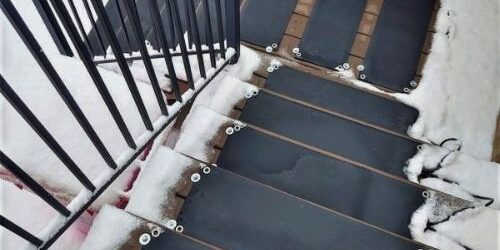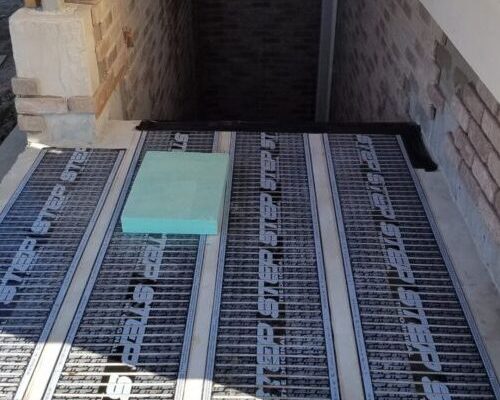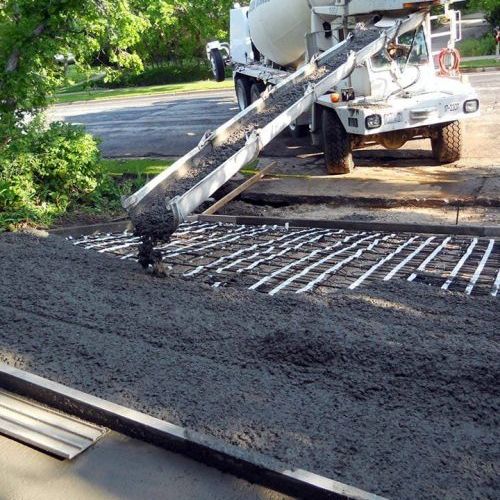Key Summary
- Heated sidewalks use radiant heat from embedded electrical cables or hydronic tubing to melt snow, enhancing safety and convenience.
- Electric heated sidewalks are easier to install, suit smaller areas, while hydronic systems, although costlier upfront, are more energy-efficient for larger areas.
- Installation cost for a heated sidewalk system ranges from $6 to $20 per square foot, and professional installation is recommended for optimal performance and durability.
How do Heated Sidewalks Work?
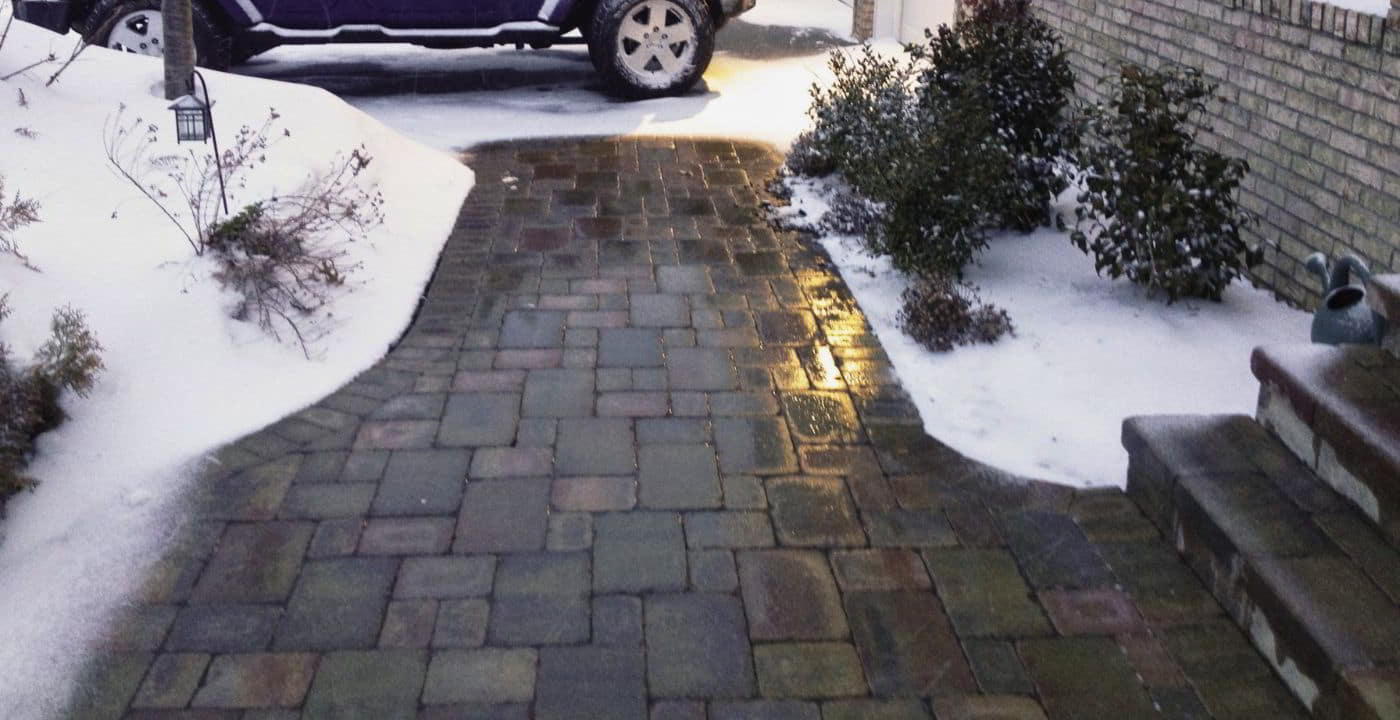
Heated sidewalks are powered by a radiant heating system which, typically, are embedded within the walkway’s concrete, asphalt, or pavers. The system has two key components:
Electrical Cables – These are capable of generating heat when switched on.
Hydronic Tubing – This circulates the heat throughout the system.
An alternative to these embedded systems are above ground melt mats. These mats, which can be connected to an outdoor power source, offer a degree of flexibility. They don’t provide the same level of power and automation as an in-ground system, but they are perfect for flexibility and less snow/frost ridden areas.
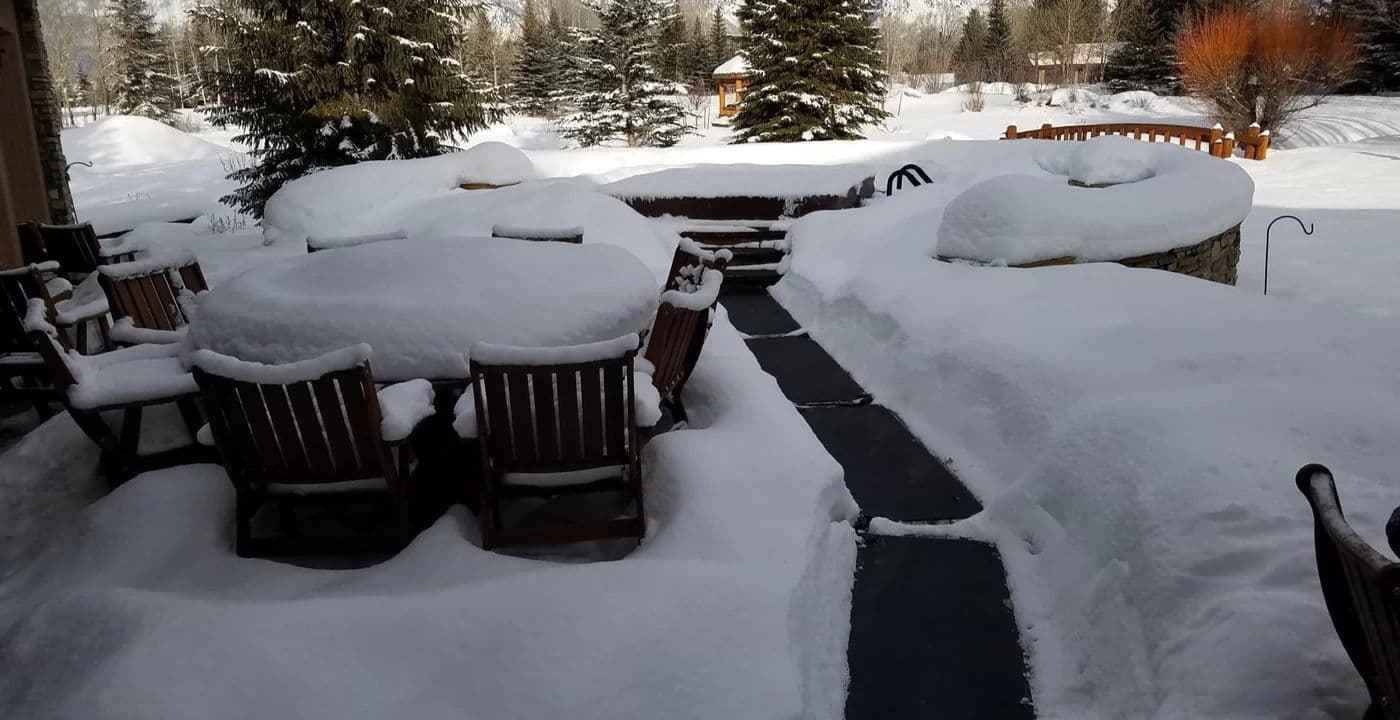
Radiant Heated Mats for Sidewalks
How Does It Work?
When the radiant heating system is activated, it creates a heat exchange with the environment. This warmth effectively melts the snow or ice that has accumulated on the surface, leaving your path dry and safe for walking.
Energy Efficiency: Electric vs Hydronic Systems
One major advantage of heated sidewalk systems is their energy efficiency. There are two main types:
Electric Radiant Systems (Electric Heated Sidewalks) – These require a lower initial investment and are easier to install, making them suitable for smaller areas.
Hydronic Systems – More efficient in terms of operational cost and heat output, these systems are ideal for larger areas.
Heated Sidewalk | Costs
When estimating heated sidewalk costs, it’s vital to consider not only the system itself but also excavation, electrical work, and materials. On average, you can expect to pay between $6 and $20 per square foot for a radiant snow-melting system.
Heated Sidewalk Product Options
Snow Melting Mats
Snow melting is made easy with Melt Mat’s Plug & Play snow & ice melting mats. These heat mats for your sidewalk, including stairs, easily plug into any standard exterior outlet offering an easy solution to snow covered grounds.
Say goodbye to the hassle of traditional snow melting systems and switch to the innovative and eco-friendly STEP Snowmelt system. Melt snow and ice from your driveway, walkway, patio, and stairs, with STEP Snowmelt’s energy-efficient snow and ice melting in-ground system.
Cable Snow Melting System
Rapid snow melting capability is right at your fingertips with ClearZone®’s industry leading cable snow melting systems.
How to Choose the Best Heated Sidewalk System for You
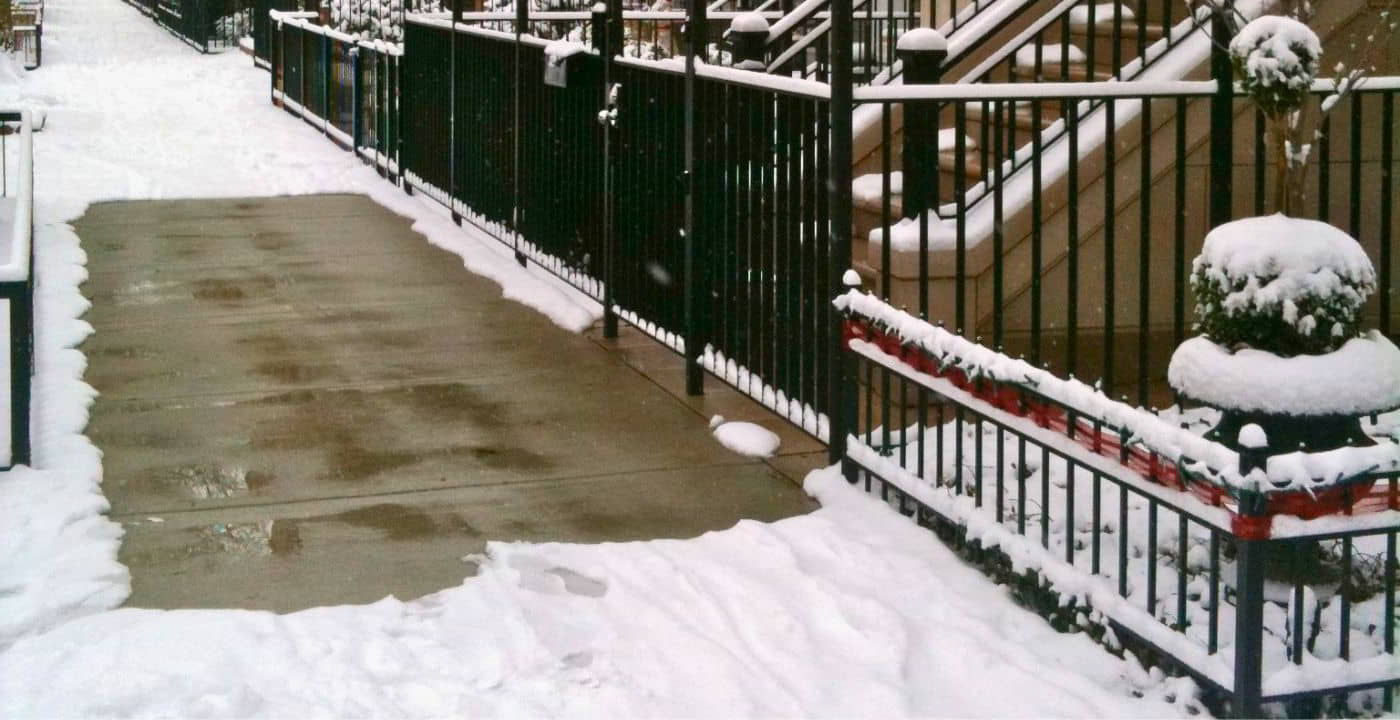
Choosing the best heated sidewalk system involves multiple factors, each playing a significant role in the final decision. You’ll need to consider climate, sidewalk dimensions, your budget, and your unique needs before finalizing a decision.
Size and Location
When deciding between an electric heated sidewalk and a hydronic system, consider the size and location of the sidewalk. Electric systems typically suit smaller walkways due to their ease of installation and lower upfront cost whereas, despite a higher initial outlay, hydronic systems are best for larger areas thanks to energy efficiency.
Climate
Climate will be an important consideration. Regions that are more prone to frequent and heavy snowfall will likely require a more robust and efficient system that can handle more extreme weather.
Budget
Lastly, your budget plays a pivotal role. An electric sidewalk snow melt system could be cost-effective initially but may incur higher operational costs in the long run. On the other hand, hydronic systems, although expensive to install, can offer significant savings over time due to their energy efficiency.
What are the Benefits of Heated Sidewalks?
Heated sidewalks offer numerous benefits, transforming how you deal with winters. These include:
Enhance Safety
Heated sidewalks significantly reduce the risk of slips and falls, a common issue in icy conditions. By preventing the buildup of snow and ice on your walkways, they ensure safe and comfortable mobility around your property, particularly beneficial for the elderly or those with limited mobility. You could also extend the installation to create a heated driveway that will ensure safety around your motor too.
Reduce Manual Labor
The convenience of heated sidewalks goes beyond mere comfort. Automatically melting the snow eliminates the arduous task of shoveling snow from your paths. This not only saves your time but also spares you the physical exertion that snow removal often entails.
Prevent Pavement Damage
Heated sidewalks safeguard your pavement from the detrimental effects of salt and chemical deicers. These substances, often used to melt snow, can degrade the quality of your pavement over time. With heated sidewalks, such damage is a concern of the past, preserving the integrity of your walkways.
Increase Pavement Longevity
The implementation of heated sidewalks can significantly prolong the life of your pavement. By mitigating the freeze-thaw cycles – the repetitive process where water seeps into the pavement, freezes, expands, and then thaws, causing damage – heated sidewalks enhance the durability of your walkways, providing a long-term benefit.
Offer Convenience with Automated Systems
Heated sidewalks, equipped with smart sensors and automated systems, provide unparalleled convenience. They activate as soon as it starts to snow and deactivate once all the snow is melted, removing the need for manual integration, and ensuring the walkways are clear and safe, regardless of weather conditions.
Improve Aesthetic Appeal
Lastly, heated outdoor walkways contribute to the aesthetic appeal of your property. They keep your sidewalks clean, clear, and well-maintained, enhancing the overall appearance of your outdoor space.
Summary | Pros and Cons of a Heated Sidewalk
| Pros | Cons |
|---|---|
| Enhances safety | High initial installation cost |
| Reduces manual labor | Can increase electricity bill |
| Prevents pavement damage | May require professional installation |
| Increases pavement longevity | Not all systems are energy-efficient |
| Automated systems available | Maintenance and repairs can be costly |
| Adds to aesthetic appeal |
Heated Sidewalk System Installation

Installing a heated sidewalk system requires careful planning and execution. We recommend professional installation to ensure proper placement of heating elements, efficient performance, and durability of the system.
Although you should have your heated sidewalk professionally installed, we would recommend having a general understanding of the installation process. Here’s a general step-by-step to help you out:
1. Plan the layout
Decide where you want to install the system. This can include walkways, porches, ramps, stairs, patios, and driveways.
2. Choose the right system
Decide between electric or hydronic systems based on your needs and preferences.
3. Excavation
Remove the existing pavement, if any, and prepare the ground for new installation.
4. Install the heating system
Lay down the heating cables or tubes as per the system’s specifications.
5. Connect the system
Attach the thermostat and sensor, ensuring they are positioned correctly.
6. Test the system
Check the system’s operation before proceeding with the final steps.
7. Pour on the flooring material
Pour on the flooring material, such as asphalt or concrete to the heated walkway. Alternatively you can place pavers down but the heating system should be completely encased in the material.
8. Final system test
Run the system once again to ensure it’s operating correctly.
Heated Walkway Maintenance
Maintaining your heated walkway ensures its longevity and efficient performance. Regular system inspections, especially before the start of the winter season, are essential. Although heated sidewalks significantly reduce the need for snow shoveling, some snow removal may still be necessary during heavy snowfall, particularly if you have a lower spec system.
Plan for ongoing expenses, such as potential repairs and the cost of running the system during the winter months. Remember that proper maintenance not only prolongs the lifespan of your heated sidewalk but also ensures that it functions optimally when you need it most.
Frequently Asked Questions
Do Heated Concrete Floors Crack?
Heated concrete floors don’t typically crack due to the heating system. Cracks in concrete are more commonly caused by environmental factors such as freeze-thaw cycles. In fact, a heated sidewalk can help prevent these cycles, reducing the chance of cracking.
What's the Difference between a Heated Mat for Sidewalk and a Heated Sidewalk System?
A heated mat for sidewalk, also known as a heated snow melting walkway mat, is a portable solution for snow and ice melting. They are placed on top of the sidewalk, plugged in, and then heat up to melt the snow. A heated sidewalk system, on the other hand, is a permanent installation within the sidewalk that melts snow as it falls.
How Long Do Heated Sidewalk Systems Last?
With proper installation and maintenance, heated sidewalk systems can last as long as the pavement itself, which is typically 20-30 years.
Conclusion
Heated sidewalks are an excellent investment, especially for those living in regions with significant snowfall. Not only do they enhance safety by preventing the build-up of ice and snow, but they also reduce manual labor and potential damage from deicers.
While the initial installation cost may be significant, the long-term benefits and convenience they provide make them worth considering. Choose the right system based on your unique needs, local climate, and budget, and enjoy a clear and safe sidewalk all winter long.
If you are keen to ditch the snow shovel, contact Greenwave Distribution today to get a free quote and discuss heated sidewalk options.





